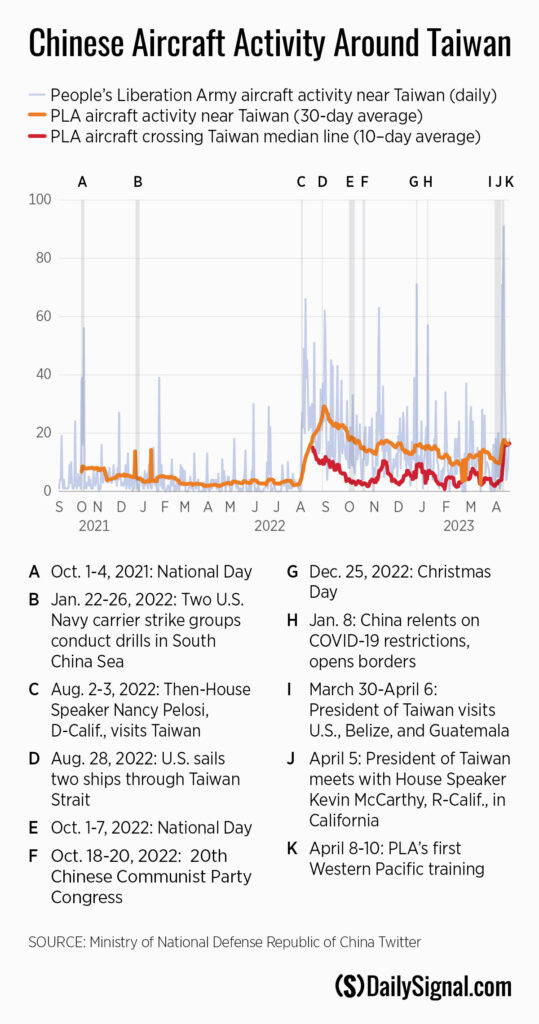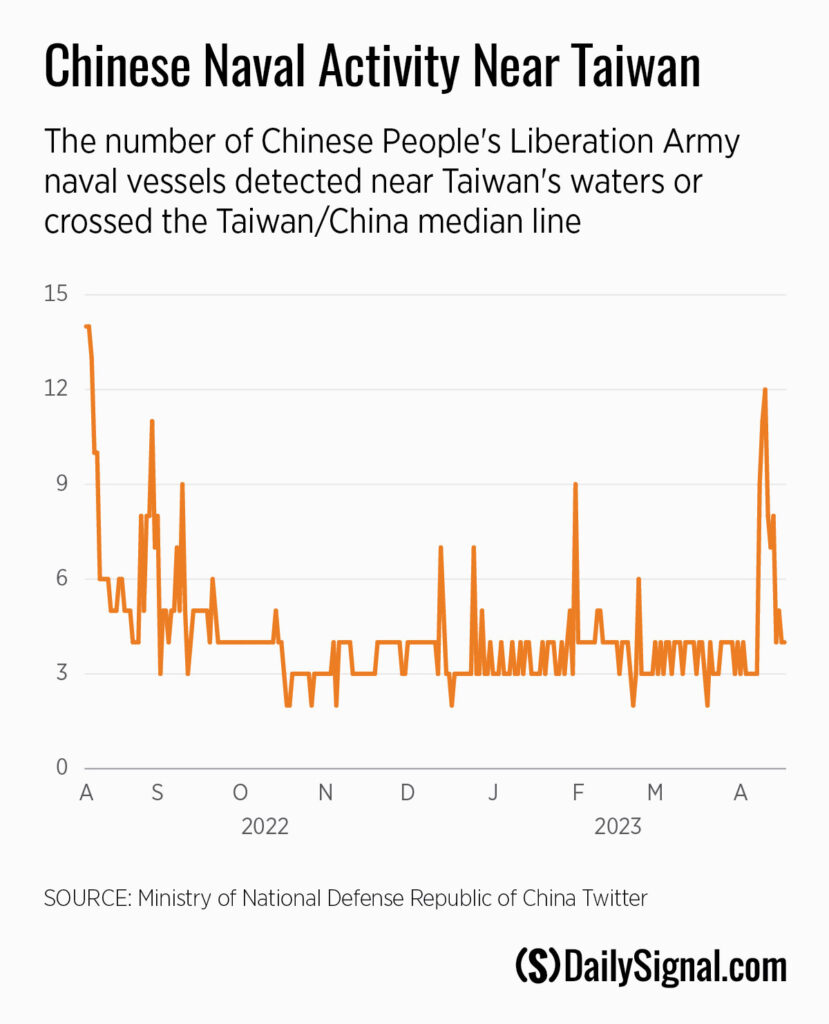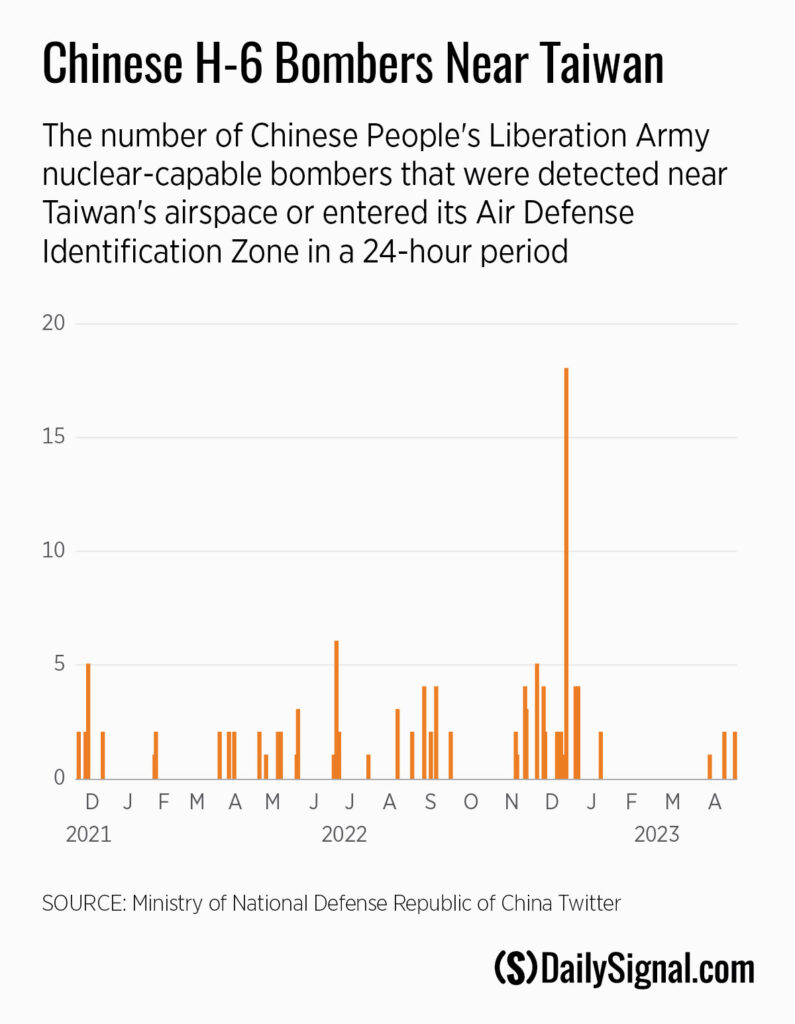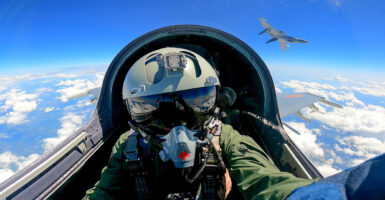In a historic event on April 5, Taiwanese President Tsai Ing-wen and U.S. House Speaker Kevin McCarthy held the highest-ranking meeting ever between a Taiwanese president and a U.S. official on U.S. soil.
During Tsai’s visit, and following a trip to Taiwan by former House Speaker Nancy Pelosi last Aug. 2, the Chinese Communist Party mobilized the People’s Liberation Army air force and navy to apply maximum pressure on Taiwan by conducting large-scale military exercises.
Notably, those elaborate displays of military strength tell us something about Beijing’s intentions in any war in the Taiwan Strait.
Data documenting the PLA’s military activities shows that heightened aggression toward Taiwan has been a frequent response by the CCP to perceived provocations. In reaction to Pelosi’s visit to Taiwan last summer, the Chinese air force incursions into Taiwan’s Air Defense Identification Zone and Chinese navy presence operations skyrocketed, triggering what experts called the “Fourth Taiwan Crisis.”
At the same time, there was a jump in the number of incursions across the unofficial “median line” dividing the Taiwan Strait. On Aug. 7, Taiwan detected 66 aircraft near its airspace in a 24-hour period while 22 Chinese planes crossed into its air defense zone. During the same period, Chinese naval activity also reached a peak, with 14 vessels operating near Taiwan.
Furthermore, from Aug. 4 to 7, the PLA established seven “exercise zones” encircling Taiwan from a number of directions and located within its air defense zone. Notably, the PLA conducted live-fire drills in these exercise zones with conventional ballistic missiles, long-range rockets, and DF-15B short-range missiles from mainland China.
Some of these missiles flew over Taiwan, while others landed near the island nation’s waters and even within Japan’s 200-nautical-mile Economic Exclusion Zone.
All of this occurred with little forewarning, indicating a degree of preparation and readiness to execute coordinated air, naval, and rocket force operations around Taiwan and thought to be a key military action should the order be given from Beijing to attack.
Following a similar pattern, in response to Tsai’s visit to California to meet with McCarthy, the PLA launched large-scale military exercises around Taiwan. Due to concern about upcoming elections in Taiwan and the suspected PLA response, Tsai’s meeting was purposefully done in the U.S., rather than in Taipei.
It was hoped this move would have defused tensions, but it didn’t change the CCP’s reactions much.
The PLA nevertheless engaged in several provocative military operations. On April 8, China officially launched the first West Pacific training—“Joint Sword” drills—of the year. On April 10, more than 90 Chinese airplanes were detected near Taiwanese airspace and 54 crossed the median line separating Taiwan and the mainland.

Over the course of the three-day exercise, Taiwan detected a total of 232 Chinese air force aircraft near its airspace, and 134 aircraft entered its air defense zone.
That compares to the 314 Chinese air force aircraft detected and 167 incursions into the air defense zone over the seven-day period following Pelosi’s visit.
In other words, the number of incursions were nearly the same in less than half the time. Similarly, Chinese naval activity around Taiwan spiked after the Tsai-McCarthy meeting, and the Chinese navy continued combat training around Taiwan after the official end date of the exercise.

While the PLA launched missiles during Pelosi’s visit to Taiwan, it did not launch any missiles during the Joint Sword drills following the Tsai visit with McCarthy. Instead, it released an animated video of missile launches against Taiwan throughout the Joint Sword exercise revealing that China has identified targets in Taiwan to destroy in an invasion, along with taking out “foreign” targets in the area as well.
Furthermore, Taiwan’s armed forces have repeatedly detected H-6 nuclear-capable bombers near their airspace, and some have even crossed into Taiwan’s air defense zone.

That said, those bombers appear to operate not directly connected to more public shows of force. On that point, the highest number of H-6 nuclear bomber uses occurred on Dec. 12, with 18 H-6s detected and little other air or naval activity noted.
Moreover, following the Pelosi and McCarthy visits with Tsai, the use of H-6 bombers was minimal, with just two bombers being the highest number detected.
Although the recent military demonstrations around Taiwan were less complex than those following Pelosi’s visit to Taiwan, they were escalatory.
Notable was the April 5 notice that China’s coast guard would initiate a three-day “special joint patrol and inspection operation” in the Pingtan-Taiwan shipping route. Despite the announcement, little publicly available information corroborates that such inspections occurred.
Though the Joint Sword drill did not involve missiles landing near Taiwan’s waters or flying over the island, China Central Television reported on the second day of exercises that several military branches under the command of the PLA Eastern Theater Command conducted simulated joint precision strikes on strategic targets on and near Taiwan.
That was the first time an official public report has revealed mock strike targets of the PLA.
That could indicate that China might be planning a larger and more aggressive drill soon, with Chairman Xi Jinping ordering the PLA to “strengthen military training oriented toward actual combat.”
This move to realistic training makes recent operations appear as practice for “sealing off” the island. Moreover, Xi went to visit the Southern Theater Command on April 11, where major joint exercises are likely this summer.
The recent politically sensitive visits occurred at an opportune time for the PLA operationally—during favorable weather conditions and at the tail end of normal military exercise periods.
Nonetheless, Taiwan and the U.S. should be on guard for the next set of exercises that the PLA conducts, given the increase in hostile rhetoric from the CCP and Xi’s recent visit to the Southern Theater Command.
Have an opinion about this article? To sound off, please email letters@DailySignal.com and we’ll consider publishing your edited remarks in our regular “We Hear You” feature. Remember to include the url or headline of the article plus your name and town and/or state.

























